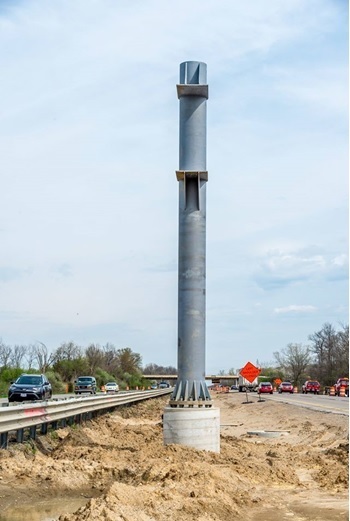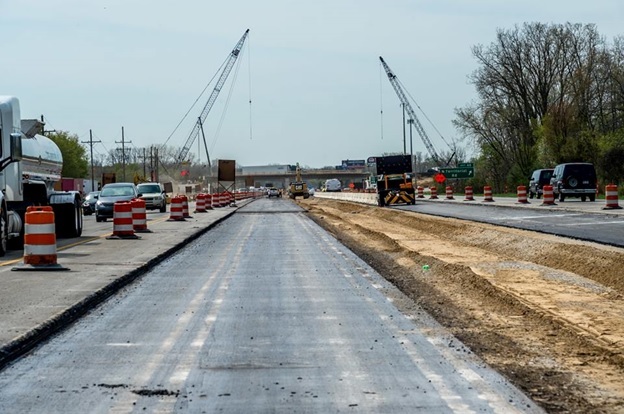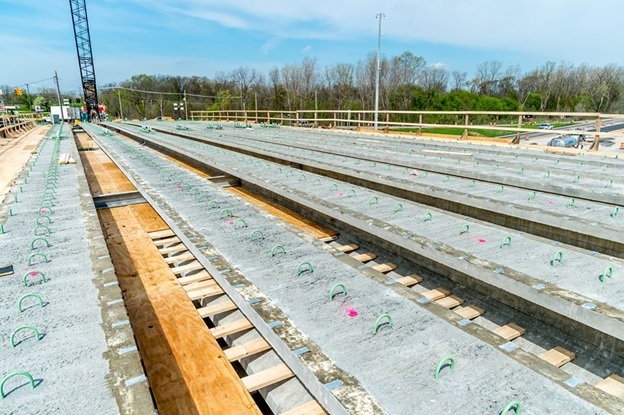Michigan DOT no topic May 2017
Michigan DOT sent this bulletin at 05/12/2017 11:58 AM EDT |
|
Having trouble viewing this email? View it as a Web page. |
May 2017
Driver awareness key to Flex Route success

|
|
Construction of a gantry support pillar. |
In the not too distant future, the currently active US-23 construction zone will be transformed into a technologically advanced active traffic management system. This new system will be Michigan's first Flex Route, geared to help eliminate traffic congestion during peak afternoon and evening travel periods.
The Flex Route will include a network of computerized overhead signs, cameras, and electronic message boards attached to overhead gantries that will constantly monitor traffic conditions. However, as with most new technology, an initial learning curve will be necessary before motorists fully grasp how the advance warning system will manage peak rush hour congestion, and promote safer travel.
Once it's fully operational, the new smart road technology system will be available along US-23 between M-14 and M-36 (9 Mile Road). As motorists approach either the northbound or southbound perimeter of the Flex Route, they will see large gantries with overhead signs that appear to frame the highway. Posted above each lane will be a lane control sign displaying key information, which will be determined by the current traffic conditions. For example, a green arrow would indicate an open lane, whereas a red X would indicate a closed lane.
"Except for special events or when highway conditions require incident management, the green arrow or red X will usually be posted over the shoulder (flex) lane, rather than over the regular travel lanes," explained Mark Sweeney, P.E., MDOT's Brighton Transportation Service Center (TSC) manager. "The signs over the regular travel lanes will typically be blank or they might post the recommended speed limit, based on the current travel conditions."
|
Motorists driving the Flex Route need to be observant of the critical information provided |
|
|
A Green Arrow... |
will be displayed above an open lane. During morning and afternoon peak travel periods, shoulder lanes will be open to improve the flow of traffic. |
|
|
|
|
A Red X... |
will be displayed above a closed lane. For example, if a lane is closed due to a traffic incident or construction ahead, a red X posted above that lane warns motorists so they can avoid the blockage. However, if traffic is not congested, a red X will appear above the lane to advise motorists that it is not currently available. |
|
|
|
|
The Recommended Speed... |
will be posted above each open lane. If traffic slows, the recommended speed limit will be posted above the open lanes to alert motorists regarding a change in conditions ahead, thus decreasing the potential for crashes. |
|
|
|
|
A Yellow Merge Sign... |
will direct motorists to merge or move over to avoid an incident or a blocked lane ahead, which also will decrease the potential for crashes. |
Because the median shoulders will be used as temporary lanes, it is critical that drivers both understand and follow the rules involved in safely driving a Flex Route. Motorists can familiarize themselves regarding how a Flex Route works by viewing this short video.
Of course, it's possible that some drivers still might not feel as comfortable as others when initially driving the new Flex Route. In that case, MDOT recommends that those motorists try handling the Flex Route in the same way drivers should handle most any traffic situation: slow down and stay to the right.
Construction of the Flex Route system will be completed by the end of 2017. In the meantime, MDOT encourages motorists to slow down in work zones to help keep both workers and motorists safe.
If you have any questions concerning the Flex Route, contact the Brighton TSC at 810-227-4681. For more information about related traffic detours, lane closures and lane shifts, go to www.flexroute23.com or connect with MDOT through social media at www.facebook.com/michigandot and www.twitter.com/mdot_a2, search using #flexroute.
Construction activities(See map)
Current traffic modifications:
- 6 Mile Road/N. Territorial Road: Traffic maintained westbound only on the 6 Mile Road bridge and eastbound only on the N. Territorial Road bridge. This temporary traffic loop uses northbound US-23 and Whitmore Lake Road as the detour. This loop will remain in place through June.
- Southbound US-23 off ramp to 8 Mile Road: Closed for reconstruction. Detour posted. Closure will last through June.
- Southbound US-23 off ramp to N. Territorial Road: Closed for reconstruction. Detour posted. Closure will last through June.
- Joy Road: Traffic is maintained on the bridge using a temporary traffic signal. This operation will last through June.
Upcoming construction/traffic modifications:
- N. Territorial on ramp to northbound US-23: The access point for this ramp will be relocated the night of May 13. The existing ramp access point from N. Territorial will be relocated to the east roughly 500 feet. A temporary signal will control traffic at this location. Westbound N. Territorial Road will be closed at the point of the relocated ramp. 5 Mile Road will remain closed during this stage.
- Northbound US-23 off ramp to N. Territorial Road: Scheduled to close the night of May 13 (weather permitting) and is expected to reopen in mid-June. This closure is needed to complete ramp reconstruction and deceleration lane extension work. Detour posted when the ramp is closed.
- US-23: Traffic shift in place expected to begin in mid-to-late May and continue through August. Includes placing all four lanes of traffic onto the temporarily widened northbound lanes of US-23 from just north of 8 Mile Road to just south of Barker Road. Southbound traffic will be shifted onto the northbound lanes using two crossovers - one placed north of 8 Mile Road and one placed south of Barker Road.
- 8 Mile Road on ramp to southbound US-23: Ramp closed during the traffic shift on US-23. This closure is needed to allow safe ramp and roundabout construction, and is scheduled to begin in mid-to-late May and continue through August.

|
|
Flex Route lane under construction. |

|
|
Overpass work along US-23. |
Flex Route concept finds success in another state
The Washington State Department of Transportation (WSDOT) recently opened a peak-use shoulder lane, which is similar to MDOT's Flex Route now under construction. The new peak-use (flex) shoulder lane is located along a 1.8-mile stretch of I-405, between State Route (SR) 527 and I-5. It was added to address weekday bottlenecks occurring during the afternoon commute, much like US-23 experiences.
Based on a May 3 article, "WSDOT caught off guard by success of I-405 shoulder driving," by Chris Sullivan, a local radio reporter, the new traffic management system made a believer out of him. He reported that, much to his surprise, travel times were reduced the first week from about 40 minutes to about 20 minutes, on average. And he said it wasn't just WSDOT saying so, based on the initial blogger feedback. One blogger wrote, "Has the drive ever been 55 mph at 5 p.m. in Bothell? Noooooo. This is amazing."
Kim Henry, who is in charge of the I-405/SR 167 improvement program, also was surprised by its success. "We were expecting to see much better performance, but this is really exceeding our expectations so far," he said.
And this is exactly what we're anticipating that Michigan's first Flex Route will do for the morning and afternoon peak drive time congestion encountered along US-23 north of Ann Arbor, from M-14 to M-36.
Frequently Asked Questions (FAQ)
Why would a different speed limit be recommended for the Flex Route when there's already one posted for US-23?
A lower recommended speed limit would be posted, for example, if motorists were approaching a traffic incident or other circumstances where slower speeds would promote safer travel, such as inclement weather and slippery roads.
What if a driver is not sure how to drive the new Flex Route?
Drivers need to familiarize themselves as to how a Flex Route works; they can start by viewing this brief video. If a driver is uncomfortable driving the Flex Route, MDOT recommends they handle it the same way that drivers should handle most any traffic situation: slow down and stay to the right.
For more details, view the Flex Route 23 brochure.
